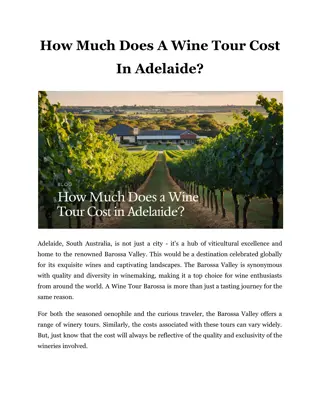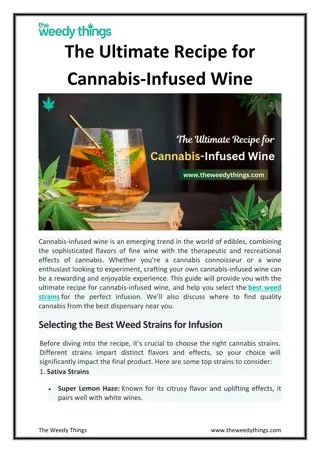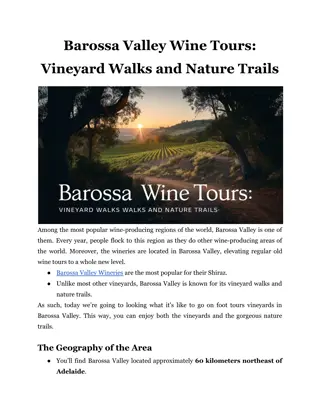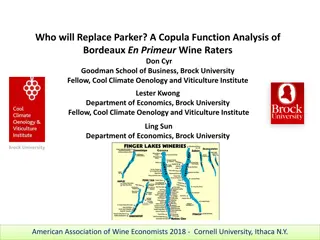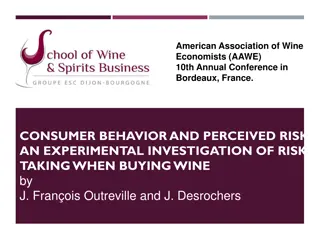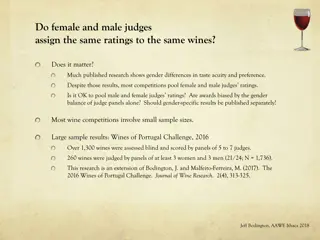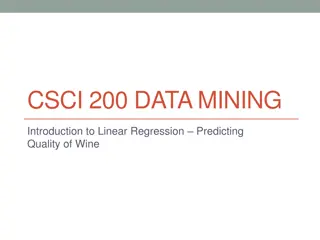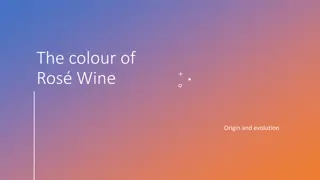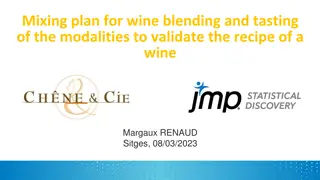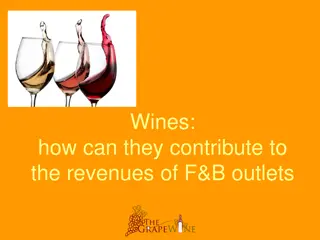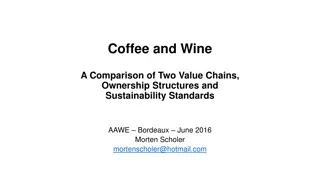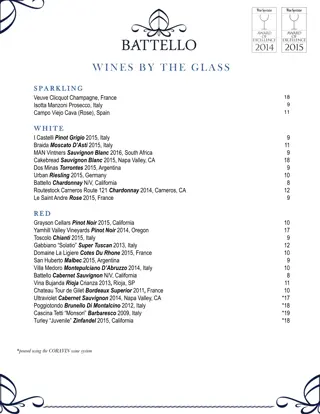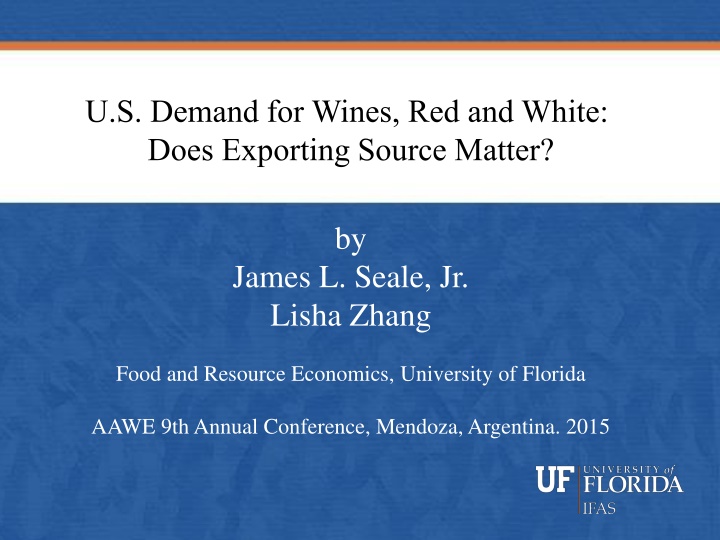
U.S. Wine Import Demand Study: Impact of Exporting Source
Explore the impact of exporting sources on U.S. wine import demand for red and white wines. This study analyzes the growth in wine imports, import shares by country of origin, and evaluates the relationships among wines from various countries. Literature reviews on import demand elasticities by country of origin are also discussed.
Download Presentation

Please find below an Image/Link to download the presentation.
The content on the website is provided AS IS for your information and personal use only. It may not be sold, licensed, or shared on other websites without obtaining consent from the author. If you encounter any issues during the download, it is possible that the publisher has removed the file from their server.
You are allowed to download the files provided on this website for personal or commercial use, subject to the condition that they are used lawfully. All files are the property of their respective owners.
The content on the website is provided AS IS for your information and personal use only. It may not be sold, licensed, or shared on other websites without obtaining consent from the author.
E N D
Presentation Transcript
U.S. Demand for Wines, Red and White: Does Exporting Source Matter? by James L. Seale, Jr. Lisha Zhang Food and Resource Economics, University of Florida AAWE 9th Annual Conference, Mendoza, Argentina. 2015
Introduction Rapid growth in U.S. wine imports has occurred over 1989-2014: Total wine imports have increased 485% in term of value and 295% in term of quantity. Red wine imports have increased 670% in term of value and 346% in term of quantity. White wine imports have increased 427% in term of value and 135% in term of quantity.
U.S Wine Import Share by Country of Origin, 2014 RED WINE WHITE WINE Rest of the World , 11% Rest of the World , 13% Italy , 32% Germany, 7% Chile, 7% Italy, 42% New Zealand, 15% Argentina, 10% Australia, 11% Australia, 8% France, 27% France, 17%
Purposes Few studies estimate the demands for red and white wine by place of origin. To do so, we fit a two stage-differential import demand system to data of total, red and white wines. Parameter estimates are used to calculate expenditure and price elasticities. We evaluate substitute or complement relationships among wines from different countries.
Literature Review Barten (1993) made a systematic comparison of four versions of differential demand systems : Rotterdam system (Theil, 1965); the Almost Ideal Demand system (AIDS) ( Deaton and Muellbauer, 1980); the Central Bureau of Statistics (CBS) system (Keller and van Driel, 1985); and the National Bureau of Research (NBR) system (Neves, 1987) CBS and NBR models are income-response variants of Rotterdam and AIDS, respectively ( Lee, Brown, and Seale, 1994)
Literature Review Studies for U.S import demand elasticities by country of origin for wine are limited. Seale, Marchant, and Basso (2003) analyze the demand for import versus domestic production for the U.S red wine market. Carew, Florkowski and He (2005) analyze demand for imported and domestic table wine in British Columbia, Canada with the AIDS model. Lee, Kennedy, and Hibun (2008) analyze an import demand system of the South Korean wine market using the source-differentiated AIDS model.
Two Stage-Method Italy Other Wine France Australia Argentina Red Wine Chile All Wine Rest of the World Italy France White Wine Australia New Zealand Germany Rest of the World
Two-Stage Demand Model The First Stage: ( ) Q ( ) ( ) = + log log log W d Q d d p g g g gh h h The Second Stage: ( ) ( ) ( ) q = + * * * log log log w d d Q d p i i i g ij j j S g The coefficients of the Rotterdam Demand Model obey the basic properties: adding-up; homogeneity; and symmetry.
Data The dataset was obtained from the Foreign Agricultural Service (FAS), the United States Department of Agriculture (USDA). The import expenditure data contain the volume and the price of wine, red and white. Unit value prices are computed by dividing the import values by the import quantities The time period ranges from 1989-2014
Choice of Models Based on Barten s model-choice method, we choose All Wine: CBS model Log-Likelihood Ratio Test Statistics: 0.41 Red Wine: Log-Likelihood Ratio Test Statistics: 4.52 CBS model White Wine: AIDS model Log-Likelihood Ratio Test Statistics: 3.54.
Expenditure Elasticities 1.04 0.86 White Wine Red Wine Country Source Country Source Italy 0.83 Italy 1.02 France 0.95 France 0.65 Australia 1.68 Australia 0.80 Chile 1.13 New Zealand 1.36 Argentina 0.78 Germany 0.98 Rest of the world 1.07 Rest of the world 0.73
Cournot Own Price Elasticity -0.70 -0.44 Red Wine Source White Wine Source Italy -0.43 Italy -0.31 France -0.25 France -0.58 Australia -0.68 Australia -0.82 Chile -0.81 New Zealand -1.14 Argentina -0.15 Germany -0.58 Rest of the world -0.71 Rest of the world -0.71
Substitute or Complement? Italy France Australia R.O.W Red Wine Italy Substitute France Substitute Australia Substitute R.O.W Substitute France Australia New Zealand R.O.W White Wine France Substitute Substitute Australia Substitute New Zealand Substitute Germany Substitute
Conclusions Countries that export wines to the U.S are few in numbers (e.g: Italy and France are major exporters for both red and white wine). The relationships between wine imported from different countries, if any, are substitutes. Most of conditional expenditure elasticities are close to one, except for Australian red wine (1.68) and Frence white wine (0.65)
Further Research Test whether red and white wines from major exporting countries to U.S. market are uniform substitutes. Simulate projected paths for red and white wines from different countries over next 10 years. Incorporate U.S. domestic wines into the analysis (Data Willing!)

